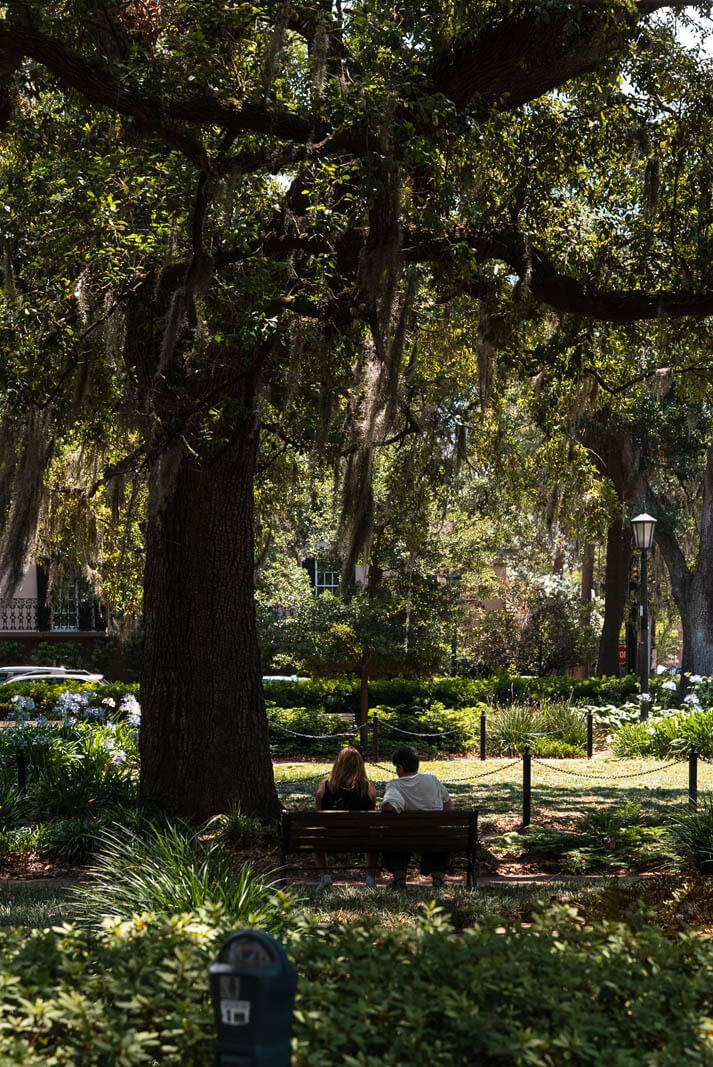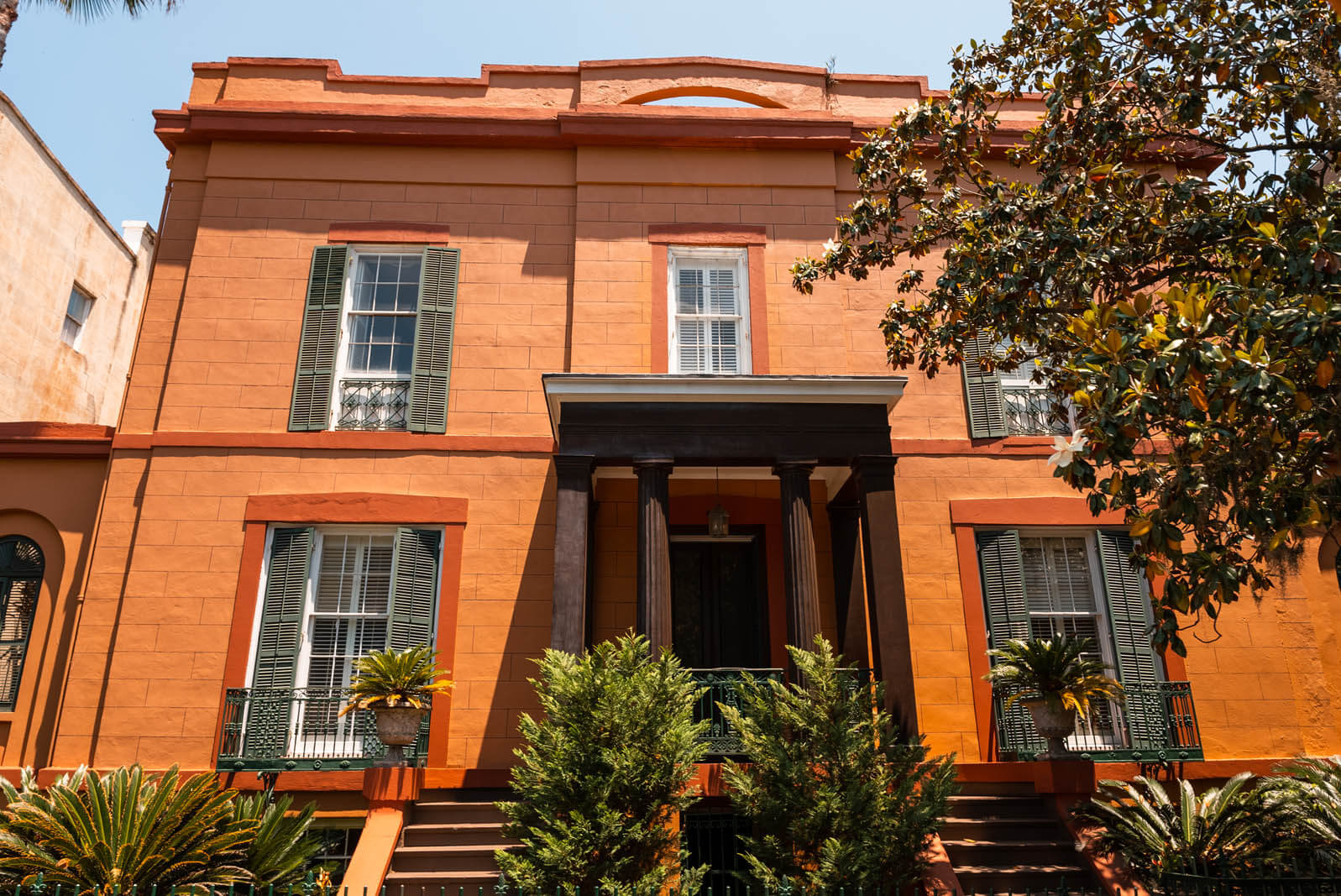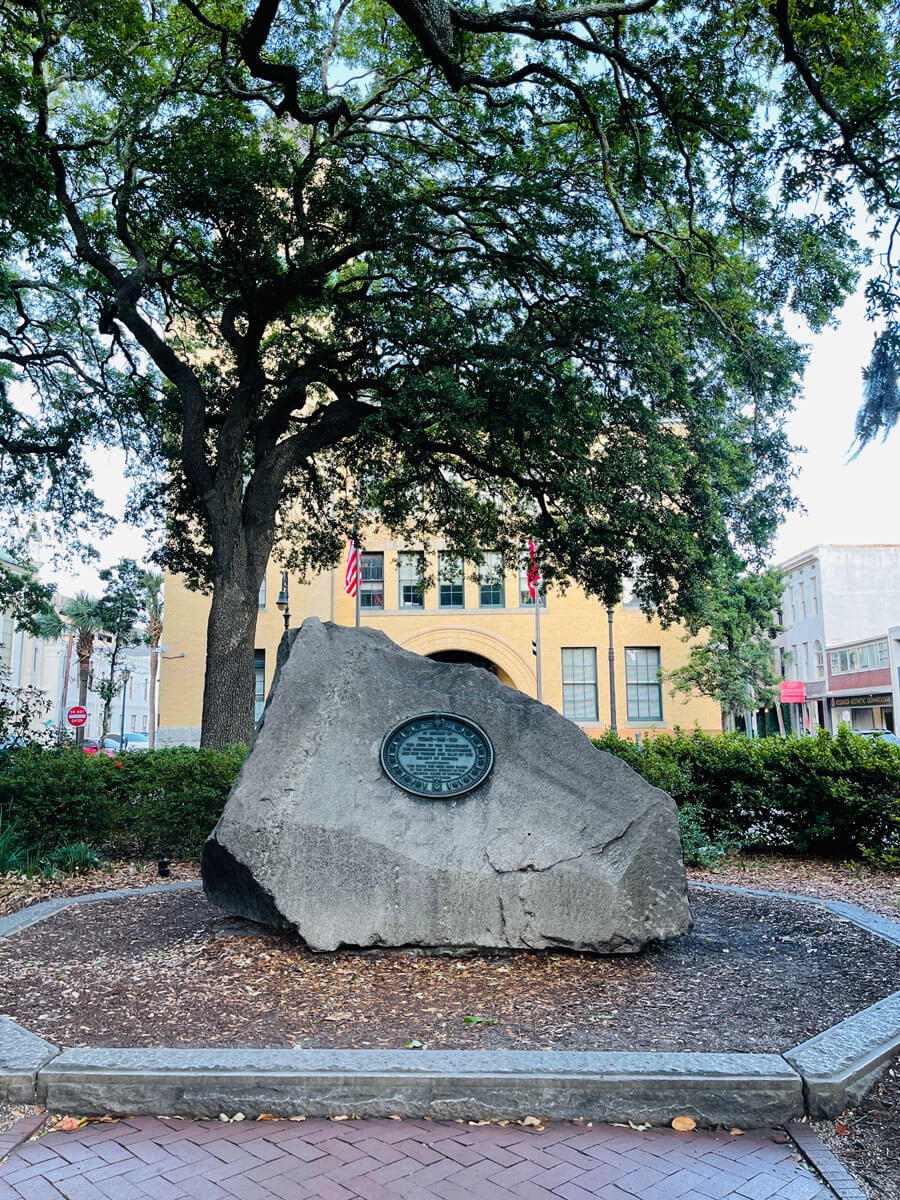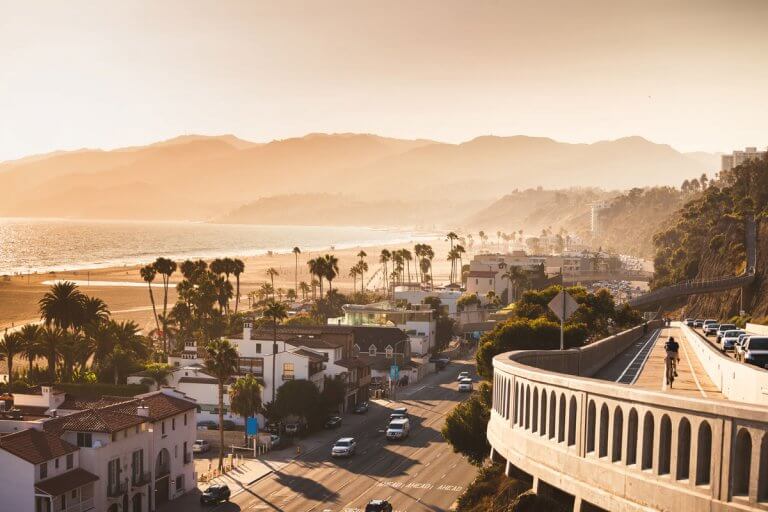Most Beautiful & Fascinating Historic Squares in Savannah to Visit
Visiting the historic squares of Savannah is a must during your visit! This incredibly beautiful city is beautiful thanks to the 22 historic squares lined with gorgeous live oak trees dripping in Spanish moss (well almost all of them!), giant mansions, and monuments in each one.
While most of the squares in Savannah are certainly pretty – they also each have their own story to tell, monuments of significance, or are surrounded by famous sites.
In this guide, we will cover what we think are the most intriguing historic squares in Savannah to visit (including the prettiest squares in Savannah to visit) plus the points of interest worth noting at each. If you’re like us, you appreciate places you visit knowing a thing or two about the significance or landmarks surrounding them!
And while you’re exploring the best things to do in Savannah, you’ll definitely be hitting up a few of Savannah’s historic squares. And if you end up going on any of the popular tours in Savannah, you’ll most likely cover some too!
And before traveling, check out our guide to our top things to know before visiting Savannah which includes local rules (like how to legally drink outside), a few things that might come up during your visit, and some background on the history of this gorgeous Southern city!
About Savannah’s Historic Squares
Back in 1733 when General Edward Oglethorpe established the colony of Georgia, he had the unique idea to create Savannah on a grid. Throughout the grid he wanted squares to be put in as public gathering spaces.
The 22 squares in Savannah today (there used to be 24) are packed with history. As the city was built and then grew up around the squares, they were for the most part left alone. Many of the squares were used during the Revolutionary War by the militia and during the Civil War as camps for the occupying Union soldiers. Some were used as cemeteries while others have been filming locations in blockbuster hits.
Historic Savannah squares are still gathering places today and serve as parks for not only the locals but visitors like us. They host musical events and farmers markets and are enclosed by some of the most beautiful mansions on the East Coast. And a lot of them are said to be haunted! Below, you’ll find a list of our favorite squares in Savannah and interest points in each of them plus their storied pasts.
Historic Squares of Savannah to Visit
Chippewa Square
One of the most popular Savannah squares is Chippewa Square. This recognizable square in Savannah is where the opening scene of the movie Forrest Gump was filmed! Forrest, played by Tom Hanks, sits on a bench in front of the square waiting for a bus. And this is where he tells his story for the majority of the movie.
Forrest’s bench was right where Bull Street intersects Hull Street on the northern side of the park. While the bench was just a movie prop, you can see it today at the Savannah History Museum! In the opening sequence of the movie, you see a feather float down past the steeple of the Independent Prebestryian Church of Savannah on Bull Street, until it floats down to the square where Forrest is sitting on the bench. You can look behind Forrest and see the manicured walkways and even the statue of General James Oglethorpe at the center of Chippewa Square.
You can still easily pose here for a photo though, you just have to lean up against the wall and get a little creative with the angle you take the photo to match the movie scene.
The statue and centerpiece to Chippewa Square in Savannah is General James Oglethorpe, the founder of Savannah and the man who was in charge of colonizing Georgia. And the square was named after the Chippewa Battle from the War of 1812.
Other notable places to mention around Chippewa Square in Savannah is the Historic Savannah Theater, built over 100-years-ago. It’s one of the oldest operating theaters in the US and functions today as a live performance venue.
And on the northwestern corner of Chippewa Square, you’ll find the beautiful Victorian-era Foley House Inn. You can book a room and still in right off the square, but you should beware that it’s known for being one of the most haunted places in Savannah! They actually found a human skeleton in the wall during renovations in 1987…eek!
Monterey Square
Next is my personal favorite of Savannah’s historic squares, Monterey Square. You’ll pass it on the way to Forsyth Park just 2 blocks south, so make it a stop on your tour of squares in Savannah! There’s a historic marker and plaque in the park from 1847 stating that the park’s name commemorates the battle of Monterey in the Mexican American War of 1846.
Monterey Square itself is picturesque with palm trees, oak trees dripping with Spanish moss, hydrangeas, cabbage roses, and more. You can enjoy a nice walk in the park or relax on a bench and be completely content.
At the center of Monterey Square is a statue of Casimir Pulaski, a Polish patriot who died fighting for America during the Revolutionary War. His remains were interred where the cornerstone of the statue was erected in 1853.
You might want to visit Monterey Square if you are a fan of Midnight in the Garden of Good and Evil. Located on the east side of the park is the famous Mercer Williams House Museum which was a huge part of the plot of the popular book and film, but even before that this is one of the most famous homes in Savannah.
Built over 150-years-ago, the house is also considered to be one of the most haunted spots in Savannah and a stop on many of the ghost tours in Savannah. There are quite a few spooky stories tied to this house, including the true crime story that is in Midnight in the Garden of Good and Evil.
The home was built for General Hugh W. Mercer, great-grandfather of the famous songwriter Johnny Mercer, who is deeply entwined with Savannah’s history. The construction was interrupted by the Civil War and General Mercer sold the unfinished house to someone else and no Mercer family member ever lived in the house despite the name. The house serves as a museum, so if you’re into the history be sure to check this out.
There are also other pretty homes that surround Monterey Square, one being the pretty pink house that used to house Alex Raskin Antiques!
Orleans Square
Close to Chippewa Square is the quiet, pretty Orleans Square. This historic square of Savannah was named to honor General Andrew Jackson for winning the Battle of New Orleans in the war of 1812. This battle helped further cement America’s claim on North America and Jackson went on to become president of the United States.
At the center of Orleans Square is a unique emerald green fountain surrounded by stone seating. It was dedicated in 1989 to early German immigrants and their positive impact on the colony of Georgia. It’s a peaceful place to sit under the live oak trees with the sounds of the fountain nearby.
You’ll also love the gorgeous 19th-century homes found around the sides of the park. At one time these homes belonged to some of the oldest and most influential families in Savannah. Today, the area is still residential and also shares space with the SCAD, the Savannah College of Art & Design.
While you’re in Orleans Square, check out the Harper-Fowlkes House. Outside the Greek Revival-style home, you can observe immaculate craftsmanship all done by enslaved people. Inside, you can take tours. The Harper Fowlkes House represents life around the early 1800s with antiques and gorgeous interior architecture.
Franklin Square
Franklin Square is right in the middle of a busy area full of some of the best restaurants, bars, clubs, and shops in downtown Savannah. Nearby, Franklin Square is also adjacent to the popular City Market down Saint Julien Street, which we recommend wandering down.
When it comes to Savannah’s historic squares, this tiny park has some interesting things for you to check out. First, the crown jewel of Franklin Square is really the adjacent First African Baptist Church. Built-in 1793, it’s the legacy of a Black minister Andrew Bryan. You can tour the church and learn about the vital role it played in harboring enslaved people as part of the Underground Railroad.
Franklin Square itself was built in 1790 and named after Benjamin Franklin, who had represented the colony of Georgia in London two decades earlier. When the square was built, it was originally called Water Tower Square and contained the city’s water supply until the end of the 1800s.
Also, the square has a beautiful monument honoring one of the rare all-Black regiments that fought for the Americans during the American Revolution. The Haitian Monument contains a sculpture of the Chasseurs-Volontaires de Saint-Domingue fighting during the Siege of Savannah in 1779.
Reynolds Square
For more historic squares of Savannah, take a stroll to Reynold’s Square. While at first glance it doesn’t seem like there’s much in the square, the red brick paths will catch your eye. The entire area is filled with lush gardens, grassy lawns, sprawling live oak trees, and centralized around a bronze statue.
This Savannah square was created all the way back in 1733 as Lower New Square. And much like other historic Savannah squares, it was renamed a few decades later to honor a local figure, in this case, John Reynolds, the first Governor of Georgia under British rule.
The monument at the center of the square is of the minister John Wesley who founded the Methodist Church. He lived in Savannah in the 1730s and even created the first ever Sunday School here. And it’s believed that the statue was erected where his house used to be.
Framing the square are some of Savannah’s biggest attractions. You’ll find The Olde Pink House here, one of our favorite restaurants and taverns, and one of the most popular places to eat in the city. Plus, it’s haunted!
On the other side of Reynolds Square is the majestic Lucas Theater, a beautifully restored performance arts theater from the 1920s. And one block south is Leopold’s Ice Cream, so pick up a few cones and head to Reynold’s Square!
Madison Square
Madison Square is one of the prettiest squares in Savannah and every corner has some kind of historic significance! It was built in 1839 and named after President James Madison. At the center of the square is a statue of Sargent William Jasper who was honored for his bravery at the Battle at Sullivan’s Island.
You can also see two old cannons here. The cannons were donated by the Savannah Armory. And they were placed in the park to celebrate the creation of Savannah’s first two highways. (This is worth mentioning only because there are two other cannons known as “Washington’s Guns” that were gifted to Savannah by General George Washington over by City Hall, the cannons are nicknamed George and Martha, so be sure to check those out too!).
Madison Square was also the site of a bloody battle during the month-long Siege of Savannah, This is when the American and French militia tried to take back the city from occupying British troops. There’s a granite marker where the British camp was and where hundreds of soldiers were killed during the battle. This is also why Madison Square is thought to be haunted!
You can tour the Sorrel Weed House, with exhibits and artifacts from the 18th century, as well as ghost tours! The house is very haunted and ghost hunter shows come here all the time.
Or visit the Green-Meldrim House, a breathtaking Gothic Revival-style mansion. General Sherman used the home as his headquarters during the Civil War. Fun fact: Sherman was gifted Savannah by President Lincoln, which is the only reason Savannah was preserved and wasn’t burnt down during his infamous ‘Shermans March to Sea’ where he campaigned heavily for the south to abandon the Confederate cause.
Off Madison Square, there’s the beautiful St. John’s Episcopal Church. And you’ll find SCAD’s main campus on the southern corner of the park. It’s in a dramatic red brick building that you have to see!
Calhoun Square
Calhoun Square is the only one of Savannah’s historic squares with all the original buildings still surrounding it. This is one of the historic squares of Savannah that really highlights dark past of the city. It was named for Vice President John C. Calhoun who served under President John Quincy Adams and the pioneer of the secession movement that eventually led to the Civil War.
Before 1851, Calhoun Square was a cemetery for enslaved people, which is a bit twisted considering Calhoun was a staunch supporter of slavery and a slave owner himself. When the square was created, the remains of the buried were moved to Laurel Grove Cemetery South, although many records of those whose remains were moved have been lost. Cemeteries were segregated in Savannah and many are fighting for the city to actually rename Calhoun Square altogether.
There’s actually a petition urging to rename Calhoun Square, as it’s long overdue. Even on the various ghost tours in Savannah, they discuss the ‘unsettled’ energies present here and some suggested that there are still unmarked graves at this site.
On the west side of the square is the Wesley Monumental United Methodist Church. It was Savannah’s first Methodist Church. Then there’s the Massie School, the first public school in Savannah that opened in 1865. Today it’s a museum.
Make a stop by Clary’s Cafe down the street. This classic diner was one of the film locations for Midnight in the Garden of Evil! And 432 Abercorn is probably the most haunted home in Savannah (pictured above). Today it’s privately owned, but it’s a common stop on haunted tours. There are a lot of bone-chilling murders and disappearances that surround the home.
Chatham Square
Chatham Square is one of the quieter historic squares in Savannah and actually one of the ‘youngest of Savannah squares’ as it was one of the last to be laid out. It’s pretty simple except for a sundial and a historic plaque or two. The square itself was named after William Pitt who held the title of the First Earl of Chatham. The county Savannah is in was also named after him.
Chatham Square is on our list because it’s just a beautiful square surrounded by homes that look like the pretty houses on Jones Street.
It’s peaceful and feels more like a residential area compared to other squares that receive a little more foot traffic with colorful rowhouses and lush gardens. Chatham Square is covered in mossy live oak trees and it makes for a nice place to sit on a bench and take in Savannah!
Ellis Square
While Franklin Square is on the west side of City Market, Ellis Square is on the east side! This square is quite different than the rest of the squares of Savannah as it isn’t surrounded by pretty homes and a canopy of trees – it’s actually quite opposite but worth mentioning since it’s so close to many of Savannah’s landmarks you’ll most likely be visiting or passing.
With a splash pad, yard games, steps, green lawns, and more, it’s a common gathering spot for families. And because it’s adjacent to the markets with all its shops and eateries, there are usually people enjoying the park.
Even though it was planned in 1733 along with the rest of Savannah’s squares, Ellis Square was lost to history. It lived as a parking garage until 2005 when the city restored the square. They named it after the second Governor of Georgia, Henry Ellis.
In Ellis Square, you’ll see a statue of Johnny Mercer, who wrote the song “Moon River” from Breakfast at Tiffany’s. Mercer was an Oscar-winning songwriter from Savannah and co-founded Capitol Records. He’s a local legend around here and you can actually visit his gravesite if you make your way to Bonaventure Cemetery during your trip.
He was loved in his hometown and there’s actually a brewery down the street named after him. Check out the Moon River Brewing Company on W Bay Street between Whitaker Street and Bull Street. Or on the southeast corner of Ellis Square is Sorry Charlie’s Oyster Bar. It’s a great break during happy hour for dollar oysters and drinks!
You can also connect to City Market on Saint Julien Street here too for more great places to hang out, shop, and have a drink.
Telfair Square
The next historic square in Savannah worth mentioning is an example of one that has been renamed from its original. St. James Square was built in 1733. About a century later, it was renamed Telfair Square to honor a Scottish emigrant named Edward Telfair. After arriving in Savannah, he became a prominent resident that had a positive impact on Savannah’s development.
The Telfair family would go on to have a huge impact on Savannah as mentioned, including the Telfair Academy which overlooks Telfair Square. This important art museum in the city has 2 builds off the square: the Jepson Center for the Arts and the Telfair Museum of Art. The museum was donated by a descendant of the same family that the square was named after.
In the park there’s a statue of a chambered nautilus, a sea creature found off the coast of Georgia. There’s also a monument to the Girl Scouts, which was founded in Savannah in 1912. And in front of the Telfair Museum, you can see 5 famous sculptures by Carl Brandt.
See the “Bird Girl” statue from the book Midnight in the Garden of Good and Evil, it’s been relocated from the Bonaventure Cemetery to the Telfair Academy Museum due to it becoming too popular of a site after interest in the story boomed in the 90s, to save the statue from deterioration it’s been added to the museum.
It’s worth mentioning one other Telfair family member who had a huge impact on Savannah, Mary Telfair, the daughter of Edward was a philanthropist and art collector who is responsible for the art in the Telfair museums, she also funded in her will the Mary Telfair Hospital for Women, which is the longest operating women’s hospital in the United States.
And if you get hungry while exploring around Telfair Square, we highly recommend Alligator Soul on the north side of the park for dinner, but you’ll want to make reservations.
Wright Square
We think Wright Square has one of the most interesting stories of all the squares in Savannah. It was originally named Percival Square and was the second square in Savannah laid. Early on it was changed to Wright Square after one of the last governors of Georgia under British rule.
It once housed Savannah’s first prison and courthouse. There’s some debate as to whether or not it was also the location of the city’s gallows. While there’s a lot of proof of this, a lot of people in the city are uncomfortable with this idea and would rather it be forgotten.
In the middle of the square is a beautiful red granite monument to William Washington Gordon. Built in 1883, it honored Gordon who was the founder of the Georgia Railroad. But this monument wasn’t the original monument in Wright Square.
City planners disregarded the remains of indigenous Yamacra Tribe leader, Tomochichi. By the way, Tomochichi only did this little thing called, “feed a bunch of white invaders so they don’t die.” A friend to Oglethorpe, after Tomochichi died, he was buried in the middle of Wright Square. Then his grave was desecrated and removed to make room for Gordon’s monument! The blatant disrespect.
True to the south’s dark roots, a bunch of society folks thought it would be great to erect a monument for a prominent businessman and politician. Tomochichi had a new monument erected in the southeast corner of Wright Square.
Some believe Tomochichi haunts the grounds or at least possesses all the random folk singers that hang out on the square!
Lafayette Square
Next on the list of historic Savannah squares is Lafayette Square, another one of the more recognizable squares. It’s named in honor of Gilbert du Motier, marquis de La Fayette, the famous Frenchman and hero of the American Revolution. This square is absolutely beautiful with an iconic, oxidated copper fountain in the middle. The scene is completed with huge grassy lawns and tons of Spanish moss hanging from oak trees.
All around Lafayette Square are some of the most breathtaking architectures in all of Savannah. There’s the Hamilton-Turner Inn. It’s famous for being one of the best Bed and Breakfasts by Better Home and Gardens. It was also the house to have electricity in Savannah, and it’s said to be the inspiration for Disney’s Haunted Mansion! We haven’t decided if we think that’s true. Oh, and it’s also haunted!
From Lafayette Square, you also have great views of the Cathedral Basilica of St John the Baptist. This is the oldest Catholic church in Georgia.
And some historic homes include that of famous American writer Flannery O’Connor, as well as the home of Juliette Low, who founded the Girl Scouts of America. Both houses offer tours.
I particularly love the pretty green fountain that serves as the centerpiece for this square too!
Greene Square
There aren’t any monuments in Greene Square, and it’s the least visited square on our list. But we suggest taking a little time to check out this park. It was, named after Nathanael Greene, a Major General in the American Revolution and a war hero.
Around the square are smaller, more unassuming houses than the ones we’ve looked at. But they’re still beautiful, full of both character and color! There are a few benches around Greene Square, and you can enjoy a nice afternoon in the square.
So, why is this square in Savannah on our list? Honestly, there’s an interesting story behind this square, and Johnson Square tied to Nathanael Greene, that made it worth mentioning! Both of which are the only two squares in Savannah that don’t grow Spanish moss – which no one has been able to figure out why even though it’s been introduced here in the past.
Nathanael Greene, might I add, hated Spanish moss as he said it reminded him of his grandfather’s beard.
A big draw to Greene Square is the Second African Baptist Church. This historical church started in 1802 but the building was redone in 1925. Minister Andrew Bryan took a chance and started this church in a predominantly white neighborhood during a troubling time for Black folks.
The church is famous for a few key points in history. The first point was when General Sherman brought the Emancipation Proclamation to Savannah. He read it here from the steps of the original Second African Baptist Church! And again, in the 60s, Dr. Martin Luther King Jr. first preached his “I Have a Dream” speech here before he took it to Washington, D.C.!
Johnson Square
Another one of the fascinating historic squares in Savannah was Savannah’s first square! Johnson Square was named after Robert Johnson. He was a comrade of James Edward Oglethorpe, and also a governor of South Carolina. Today, the square is surrounded by banks, earning the nickname “Bank Square,” and it gets a lot of traffic during the day.
Johnson Square is stunning with views of the city hall at the end of Bull Street to the north. The entire square is full of wide brick walkways, and a massive monument to Nathanael Greene. In fact, both Greene and his son were buried under the monument, which confuses people since his remains are here not Greene Square!
You can also enjoy a few fountains and huge live oak trees. And as mentioned above, interestingly, the live oaks in Johnson Square don’t have Spanish moss on them just like Greene Square, you know both of the squares that are somehow connected to Nathanael Greene!
The reason for this is a mystery. There are all kinds of speculations, mostly of the ghostly kind. The most popular belief is that somehow Greene is able to ward off the Spanish moss since he hated it. But some research also suggests that it’s actually thought that it has to do with the tall buildings surrounding the square.
Pulaski Square
Another one of the more secluded of Savannah’s squares is Pulaski Square. This is also one of the confusing squares that is named after someone, but their monument is in another square! Maybe you remember the centerpiece for Monterey Square, earlier on this list, was a statue of Casimir Pulaski, a Polish patriot who died fighting for America during the Revolutionary War. His remains were interred where the cornerstone of the statue was erected in 1853.
He passed away from wounds in the Siege of Savannah in 1779 and this square was named in his honor. There are no other monuments in this square, just a ton of live oaks, shrubbery, and benches you can have a nice quiet sit on.
The two oldest homes that surround Pulaski Square include the Theodosius Bartow House, which Francis S Bartow lived in before passing in the Civil War – he was the first high-ranking officer from Georgia (and a Confederate) who passed away in the war, the other home being the Bernard Constantine House.
Oglethorpe Square
We are going to end this list of historic squares in Savannah with Oglethorpe Square, named after General James Oglethorpe, who is the reason behind the squares to begin with. Oh, and Oglethorpe Square is one of the original 6 colonial squares built in Savannah and originally named Upper New Square.
Located one block north of Colonial Park Cemetery, the oldest cemetery in Savannah. There are no monuments here, in fact, you can find Oglethorpe’s monument and statue in another square like many other figures who have monuments and squares dedicated to them here in Savannah. His statue is found and serves as the centerpiece of Chippewa Square, aka the Forrest Gump bench square.
Notable landmarks that surround Oglethorpe Square include the Owens Thomas House and Slave Quarters, an antebellum-style mansion that’s a blend of Classic Revival and Georgian styles of architecture. The house now serves as a historic museum by the Telfair Museums that contains interiors from the English Regency period. This is also the oldest house on this historic square dating back to 1819.
Another history tid bit was that the home of John Reynolds, Georgia’s first Royal Governor, was located at the site of the parking lot at The Presidents’ Quarters Inn.
Enjoyed this guide to the best historic squares in Savannah to visit? Bookmark for later or share the love below on Pinterest and be sure to visit as many as you can in your Savannah itinerary.































